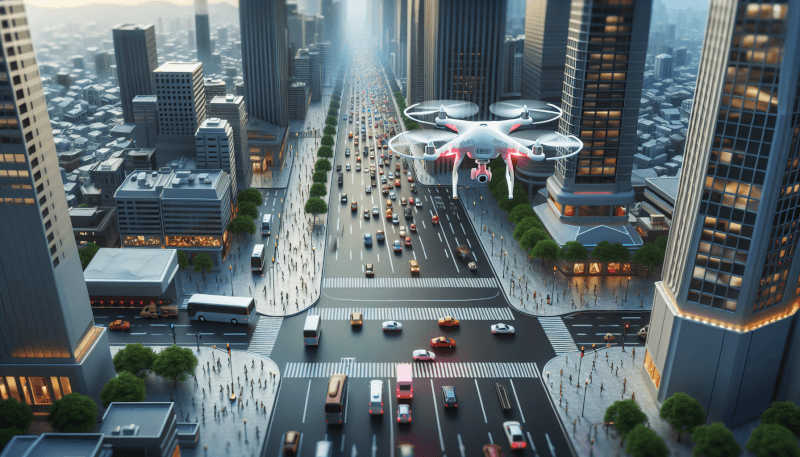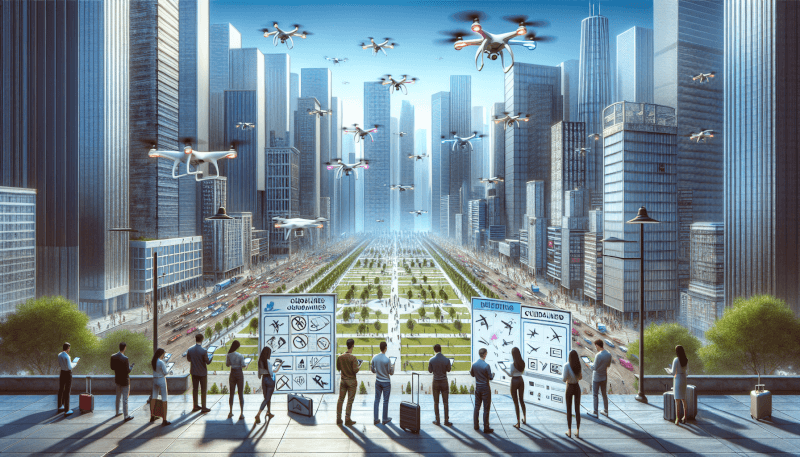Flying drones in urban areas can be an exhilarating experience that allows you to capture breathtaking aerial footage and explore new perspectives. However, it’s important to prioritize safety to ensure a smooth and incident-free flight. Whether you are a seasoned drone pilot or just starting out, this article will provide you with the top safety tips for flying drones in urban areas. From understanding airspace regulations to avoiding crowded areas, these tips will help you navigate the urban skies with confidence. So grab your drone and get ready to soar to new heights safely!

Choosing the Right Drone
When it comes to selecting a drone suitable for urban areas, there are several factors to consider. First and foremost, you need to ensure that the drone you choose is appropriate for urban flying conditions. This means opting for a drone that is compact in size and lightweight, as maneuvering through urban environments can be challenging. It’s also essential to consider the noise level of the drone, as some urban areas have noise restrictions that you need to abide by.
Considering the Size and Weight of the Drone
The size and weight of the drone play a crucial role in its maneuverability and suitability for urban areas. Smaller drones are generally more maneuverable and can navigate through tight spaces with ease. Additionally, lighter drones tend to be quieter, which is beneficial when flying in busy urban areas. By selecting a drone that is compact and lightweight, you can ensure that it is appropriate for the unique challenges present in urban environments.
Understanding the Drone’s Capabilities and Limitations
Before taking your drone to the skies in an urban area, it’s essential to understand its capabilities and limitations. Familiarize yourself with the drone’s flight modes and features, such as obstacle avoidance systems, to ensure you can utilize them effectively. Additionally, be aware of the drone’s battery life and flight time to avoid any unexpected issues during flight. Understanding these aspects will enable you to make informed decisions and fly the drone safely in urban environments.
Checking Legal Requirements
Flying a drone in urban areas comes with certain legal obligations, and it’s crucial to be aware of them to avoid any legal troubles. Researching local drone regulations should be your first step. Different areas may have varying rules and restrictions regarding drone flight, such as altitude limits and permitted areas for flying. Additionally, you may need to obtain necessary permits or licenses before flying your drone in certain urban areas. By understanding and adhering to these legal requirements, you can ensure a safe and lawful flying experience.
Researching Local Drone Regulations
To fly a drone safely in urban areas, you must research and understand the local drone regulations specific to your location. Each country and even individual cities may have their own set of rules and restrictions regarding drone flight. These regulations might include flight altitude limits, proximity to buildings or people, and even designated no-fly zones. By familiarizing yourself with these regulations, you can ensure that you are flying your drone in compliance with the law and minimizing potential risks.
Obtaining Necessary Permits or Licenses
In some urban areas, you may need to obtain specific permits or licenses before flying your drone legally. These requirements could depend on factors such as the drone’s weight, the purpose of flight, or the intended flight location. It’s important to check with local aviation authorities or relevant governing bodies to determine if you need to obtain any permits or licenses. By taking the necessary steps to comply with the regulations, you can fly your drone confidently and avoid any legal complications.

Understanding Restricted Airspace and No-Fly Zones
Certain areas in urban environments, such as airports, military installations, and government buildings, are designated as restricted airspace or no-fly zones. It is crucial to understand these restricted areas and avoid them when flying your drone. Placing your drone in these areas can pose a threat to manned aircraft or national security, and violating these restrictions can result in severe consequences. Familiarize yourself with the boundaries of these zones and plan your flight accordingly to ensure the safety of both your drone and those on the ground.
Pre-flight Preparation
Pre-flight preparation is an essential step to ensure a safe and successful drone flight in urban areas. Performing a thorough pre-flight check is the first task on the list. Inspect the drone for any visible damage, ensure the propellers are secure, and check that all the necessary components are in working order. Additionally, you should ensure that the drone’s batteries are fully charged to avoid unexpected power loss during flight. Lastly, calibrate the drone’s compass and GPS to ensure accurate flight performance and navigation.
Ensuring the Drone’s Batteries are Fully Charged
One of the most critical aspects of pre-flight preparation is ensuring that the drone’s batteries are fully charged. Flying a drone with a partially depleted battery can lead to unexpected power loss and potentially unsafe situations. Before taking off, double-check the battery levels and make sure they are sufficiently charged to complete your intended flight. Keeping spare batteries on hand is also recommended, as it allows you to extend your flight time and be better prepared for any unforeseen circumstances.
Calibrating the Drone’s Compass and GPS
Calibrating the drone’s compass and GPS is another essential step before launching your drone in an urban area. Compass calibration ensures that the drone can accurately determine its orientation, while GPS calibration enables precise positioning and navigation. Failing to calibrate these components can result in flight instability and inaccurate flight data, making it essential to perform these calibrations in a suitable location away from magnetic interference. By calibrating the drone’s compass and GPS, you can ensure a stable and reliable flight.
Understanding the Flight Environment
Before taking off, it’s crucial to survey the urban area where you plan to fly your drone for potential hazards and obstacles. Urban environments are often densely populated, with numerous structures and power lines that can pose a risk to the drone during flight. Identify any potential obstacles or obstructions that could impede your flight path, such as trees, buildings, or other aerial equipment. Additionally, assess the presence of bystanders and wildlife in the area to ensure their safety and avoid any interference with your flight.
Surveying the Urban Area for Potential Hazards
Surveying the urban area for potential hazards is an integral part of ensuring a safe drone flight. Look for any obstacles that might impede your drone’s flight path, such as tall buildings, construction cranes, or power lines. Trees and other vegetation can also pose a risk, as they can interfere with the drone’s propellers and potentially cause a crash. By identifying these hazards beforehand, you can plan your flight route accordingly and mitigate any risks to your drone and the surrounding environment.

Identifying Obstacles and Obstructions
In an urban area, there are often numerous obstacles and obstructions that you need to be aware of when flying your drone. From towering buildings to aerial infrastructure like antennas and satellite dishes, it’s crucial to identify these potential obstacles and plan your flight path accordingly. By understanding the layout of the area and being mindful of these obstructions, you can navigate your drone safely and prevent any collisions or damage.
Assessing the Presence of Bystanders and Wildlife
When flying a drone in urban areas, it’s essential to be mindful of the presence of bystanders and wildlife. People walking on the streets or enjoying urban parks might not anticipate the presence of a drone and could potentially be startled or disturbed by its flight. Additionally, wildlife can be easily spooked by the drone’s presence, leading to unpredictable behavior. By assessing the presence of both bystanders and wildlife, you can adjust your flight plans and maintain a safe distance to ensure the well-being of everyone involved.
Maintaining Visual Line-of-Sight
To ensure a safe and controlled flight, it’s necessary to keep the drone within your visual line-of-sight at all times. Visual line-of-sight means that you can see the drone with your own eyes, without relying solely on the drone’s camera or other devices. By maintaining visual contact, you can immediately respond to any potential obstacles or emergencies that may arise during flight. Avoid flying your drone behind buildings or into obstructed areas where maintaining visual line-of-sight becomes challenging.
Avoiding Flying Behind Buildings or Obstructed Areas
Flying behind buildings or into obstructed areas can result in the loss of visual line-of-sight, making it difficult to control the drone and navigate safely through the urban environment. When flying, always ensure that you have a clear line of sight to your drone to maintain full control and awareness of its surroundings. By avoiding flying behind buildings or into obstructed areas, you can mitigate the risk of losing visual contact and ensure a safer flight experience.
Using Visual Aids for Enhanced Visibility
In situations where maintaining visual line-of-sight becomes challenging, using visual aids can enhance the visibility of your drone. One of the most common visual aids is the use of brightly colored propellers, which can make the drone more visible against the sky or urban backdrop. Additionally, attaching LED lights or other lighting accessories to the drone can improve its visibility, especially during low-light conditions. By using these visual aids, you can enhance the visibility of your drone and maintain better control and situational awareness during flight.
Avoiding Busy Areas and Crowds
When flying a drone in urban areas, it’s crucial to steer clear of busy streets and public gatherings. Flying over crowded areas increases the risk of accidents or injuries, as the drone may become a distraction or potentially collide with people or vehicles. Respect people’s privacy and safety by choosing flight paths that avoid crowded areas and by maintaining a safe distance from vehicles and pedestrians. By doing so, you can prevent any unwanted incidents and ensure a responsible and safe flight.

Being Mindful of People’s Privacy and Safety
Respecting people’s privacy and safety is of utmost importance when flying a drone in urban areas. Avoid flying your drone over private properties without obtaining consent from the property owners. Additionally, be cautious of capturing images or videos of individuals without their consent. Respecting people’s privacy rights ensures that you fly your drone responsibly and avoid any unnecessary invasion of privacy or legal complications.
Maintaining a Safe Distance from Vehicles and Pedestrians
To prevent accidents and ensure the safety of both your drone and others, it’s essential to maintain a safe distance from vehicles and pedestrians. Drones can pose a risk to vehicles if they collide and can potentially injure pedestrians if they lose control or malfunction. By keeping a safe distance, you can minimize the risk of accidents and injuries and demonstrate responsible and ethical drone operation.
Fly Responsibly and Ethically
Flying a drone in an urban area requires responsible and ethical behavior. Respect the privacy and property rights of others by avoiding flying over private properties without permission. Additionally, when capturing images or videos, obtain consent from individuals if they are identifiable. Avoid any intrusive or reckless behavior that could cause harm, disturb others, or violate any legal or ethical standards. By flying responsibly and ethically, you not only ensure the safety of your drone but also uphold the integrity of the drone community as a whole.
Respecting Privacy and Property Rights
Respecting privacy and property rights is crucial when flying a drone in an urban area. Always be mindful of the boundaries of private properties and avoid flying over them without obtaining prior consent from the property owners. Understand that individuals have the right to their privacy, and capturing images or videos of people without their permission can be intrusive and disrespectful. By respecting privacy and property rights, you maintain a positive and responsible image as a drone pilot.
Obtaining Consent When Capturing Images or Videos
When capturing images or videos with your drone, it is essential to obtain consent from individuals if they are identifiable. This is especially important when flying in urban areas where there may be a higher concentration of people. Before capturing any footage that could potentially include someone’s face or personal information, approach the individuals involved and ask for their consent. Respecting their privacy rights ensures that you operate your drone in an ethical and considerate manner.
Avoiding Intrusive or Reckless Behavior
Maintaining a respectful and responsible approach when flying your drone in urban areas means avoiding any intrusive or reckless behavior. This includes flying too close to people, following them without their consent, or intentionally causing distress or alarm. Additionally, refrain from flying in a manner that could disturb wildlife or interfere with their habitats. Demonstrating responsible and ethical behavior when flying your drone ensures a positive representation of the drone community and minimizes any negative impact on the environment and those around you.

Monitoring Weather Conditions
Monitoring weather conditions is crucial for the safe operation of your drone in urban areas. High winds can affect the drone’s stability and control, potentially leading to accidents or loss of control. Check weather forecasts to ensure that you won’t be flying in adverse weather conditions such as rain, snow, or fog. Additionally, be aware of temperature limits specified by the drone manufacturer, as extreme temperature variations can affect battery performance and flight stability. Monitoring the weather conditions allows you to make informed decisions and ensures a safe and successful flight.
Checking Forecasts for High Winds or Adverse Weather
Before taking your drone to the skies in an urban area, check weather forecasts for any indications of high winds or adverse weather conditions. Strong winds can significantly impact your drone’s flight stability and maneuverability, making it difficult to control. Rain, snow, or fog can obscure visibility and make it challenging to navigate safely through the urban environment. By checking forecasts for high winds or adverse weather, you can plan your flight accordingly and avoid any unnecessary risks.
Avoiding Flying in Rain, Snow, or Foggy Conditions
Flying a drone in wet or foggy conditions presents numerous risks and can compromise the safety of your flight. Rain or snow can damage the drone’s electronic components and affect its performance. Additionally, foggy conditions reduce visibility, making it difficult to maintain visual line-of-sight and avoid obstacles. To ensure the safety of your drone and those around you, it’s best to avoid flying in these weather conditions altogether. Wait for clear skies and optimal weather conditions before embarking on your drone flight.
Being Aware of Temperature and Humidity Limits
Temperature and humidity can impact the performance and reliability of your drone. Extreme temperatures can affect battery life and performance, reducing the overall flight time and potentially leading to unexpected power loss. High humidity levels can also negatively impact the drone’s electronic components and potentially cause damage. Consult your drone’s specifications and recommendations regarding temperature and humidity limits, and avoid flying your drone beyond these thresholds. By being aware of these limits, you can ensure a safe and efficient flight in urban areas.
Emergency Procedures
Despite taking all necessary precautions, emergencies can still occur during drone flights. Being prepared and knowing how to handle emergency situations is crucial to minimize potential damage and ensure the safety of those around you. Familiarize yourself with emergency landing procedures specific to your drone model and practice them in a safe environment. Understanding the drone’s return-to-home function can also be invaluable in case of unexpected circumstances. Lastly, be prepared for potential equipment failures by having backup components or spare parts readily available. By being prepared for emergencies, you can act swiftly and effectively to protect your drone and others.
Knowing How to Initiate an Emergency Landing
Sometimes, circumstances may arise where you need to quickly bring your drone down to the ground. Knowing how to initiate an emergency landing is essential in these situations. Become familiar with the emergency landing procedures specific to your drone model and practice them regularly. Ensure that you have enough open space to perform an emergency landing and execute the procedure calmly and safely. By knowing how to initiate an emergency landing, you can respond swiftly to unforeseen circumstances and prevent any further damage or risks.
Understanding the Drone’s Return-to-Home Function
Most drones are equipped with a return-to-home function, which allows the drone to automatically navigate back to its takeoff point. Understanding how this function operates is critical if you encounter unexpected situations during flight. By activating the return-to-home function, you can ensure that your drone returns safely, especially if you lose control or the drone encounters technical issues. Familiarize yourself with the specifications and requirements of the return-to-home function on your drone, ensuring that it is properly calibrated and functioning correctly.
Preparing for Potential Equipment Failures
While rare, equipment failures can occur during drone flights. It’s crucial to prepare for these situations to minimize potential damage and ensure the safety of those in the vicinity. Have backup components or spare parts readily available, such as extra propellers or batteries, in case of a failure. Additionally, familiarize yourself with troubleshooting procedures and practice them beforehand. By being prepared for potential equipment failures, you can respond quickly and effectively, ensuring the safety of your drone and those around you.
Continued Learning and Improvement
As a drone pilot, it’s important to embrace a mindset of continuous learning and improvement. Staying updated on drone regulations and guidelines is crucial, as they are subject to change and evolve over time. Make an effort to participate in drone flight training programs to enhance your skills and knowledge. Learning from experienced drone pilots and being open to feedback can also help you improve your flight techniques and safety practices. By continuing to learn and improve, you can become a more proficient and responsible drone pilot, contributing to the overall safety and reputation of the drone community.
Staying Updated on Drone Regulations and Guidelines
Drone regulations and guidelines are continually evolving, and it’s crucial to stay updated on any changes or revisions. Keep yourself informed about the latest regulations specific to your country or region. This includes any updates regarding flight restrictions, altitude limits, or permitted areas for flying. Additionally, familiarize yourself with any guidelines or best practices provided by aviation authorities or relevant governing bodies. By staying updated on drone regulations and guidelines, you can ensure that you are flying your drone in compliance with the law and promoting safe and responsible drone operations.
Participating in Drone Flight Training Programs
Participating in drone flight training programs can be invaluable in enhancing your skills, knowledge, and overall flight safety. These programs provide hands-on experience and practical guidance on various aspects of drone flight, including navigation, emergency procedures, and risk awareness. Look for reputable training programs or workshops offered by certified instructors or drone organizations. By actively participating in these programs, you can gain valuable insights, refine your flying techniques, and stay up-to-date with the latest industry standards and safety practices.
Learning from Experienced Drone Pilots
Learning from experienced drone pilots can significantly contribute to your growth as a drone pilot. Engage with the drone community, whether it’s joining local flying clubs, attending meetups, or participating in online forums. Connect with experienced pilots who can share their knowledge, insights, and experiences. They can provide valuable advice on flight techniques, risk management, and safety practices. By learning from experienced drone pilots, you can tap into a wealth of knowledge and expertise, accelerating your learning curve and becoming a safer and more proficient pilot.
In conclusion, flying a drone in urban areas requires careful consideration, preparation, and adherence to safety guidelines. By choosing the right drone, understanding legal requirements, preparing for flight, being mindful of the flight environment, and respecting privacy and safety, you can ensure a safe and responsible drone flight. Continuously updating your knowledge, participating in training programs, and learning from experienced pilots further enhance your skills and contribute to the overall safety and reputation of the drone community. With careful planning and responsible piloting, you can enjoy the thrill and benefits of urban drone flying while maintaining the highest standards of safety and professionalism.


